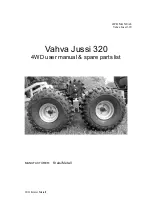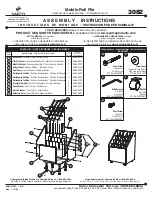
Page 11 of 17
This document is a collaboration between Martin forsberg, Sweden, and Euan MacKenzie, Australia. Copyright Martin Forsberg &
Euan MacKenzie 2010-11-18
In the AVO CT160, and also the Mk III and Mk IV, the same current is supposed to flow through the meter
at the centre of the SET ~ calibration region on the meter scale. The centre of this area is usually marked
by a red line, which is aligned with the 90mA line, or 90% of FSD.
However on some meters this red colour may have faded completely, so you have to use either the centre
of the black area as a reference, or use the 90mA line. Alternatively, you could test your meter to check
that it is giving the correct deflection, compared to the scale; then you can mark your own point on the
scale where the needle shows 90% of FSD.
What is it we really we wish to accomplish with the calibration resistors
Ω
The important thing to
understand is that the calibration resistors are not part of the actual measurement done on the valve in the
TEST or GAS positions, only in the other leakage and insulation tests. The calibration resistors are not
only there to give you a reading that tells you that your tester is still in working order, compared to the last
time it was calibrated, and that you have chosen the correct mains voltage setting (for the measurement
that you intend to perform) but also to deliver a current that is used for other measurement purposes!
Measurements may be performed when the needle is within the black area of the SET ~ region, but it
should be close to the red line in the centre for the ‘best’ correlation to the calibration performed
previously. However the current through the calibration resistors is also used to perform the insulation and
leakage tests; so in order for these to give the correct results, the calibration current must also be correct.
The valve, V1(B), is supplied by the voltage from the 55Vrms winding; as that voltage is in phase with the
Anode and Screen voltage, and the valve under test itself acts as a rectifier in the AVO CT160, and in the
Mk III. (However, in the AVO Mk IV, the Anode voltage is already rectified by a silicon diode). The voltage
from the 66V rms winding is only used to keep the grid negative, during the half cycle where the anode of
the valve is driven negative by the AC Anode voltage, and is not used for any measurement purposes in
the TEST and GAS positions. According to the AVO Patent No. 606707, this is to ensure that no current is
drawn through the diode formed by the grid and cathode, when no anode current is flowing, which could
damage the valve’s emission.
This means that it is very important to make sure that the Anode and Screen voltages are correct, by
means of the SET ~, and then set the grid voltage correctly via RV3. The additional voltage from the 66V
RMS winding means that there are two voltages that need to be correct on the transformer, for the needle
to read the calibration region. This then works as an extra measure to ensure that the transformer
voltages are correct. Since the 66Vrms winding is part of the Anode/Screen voltage windings, you have
thus ensured that they are also correct (apart from a possibility of open circuit somewhere else in the
transformer). In the AVO Mk III and Mk IV, the additional voltage is also taken from the Anode/Screen
volts windings, so you have the same function there.
In the AVO Mk III and Mk IV, you have an extra potentiometer in the SET ~ calibration circuit, which
means that you can adjust the deflection of the needle when you have made quite sure that the grid
voltage control and Anode & Screen voltages are correct. However in the AVO CT160 you do not have
such a potentiometer; so it is even more important here that you have checked that the Anode, Screen
and Grid control voltages are correct, (apart from all the other components of course), otherwise you will
not get the correct reading on the meter.
All this means that you need the calibration resistors for two purposes, one is to ensure that the voltage
settings are correct, so that the Anode, Screen and Grid voltage controls will deliver the correct voltages in
the TEST and GAS positions, and also to ensure that the current at the other measurement positions is
correct.
This dual purpose means that you need these calibration resistors to have the correct resistance for the
measurements to be correct.
Summary of Contents for 160A
Page 1: ......
Page 19: ......
Page 20: ......
Page 21: ......
Page 22: ......
Page 23: ......
Page 24: ......
Page 25: ......
Page 26: ......
Page 27: ......
Page 28: ......
Page 29: ......
Page 30: ......
Page 31: ......
Page 32: ......
Page 33: ......
Page 34: ......
Page 35: ......
Page 36: ......
Page 37: ......
Page 38: ......
Page 39: ......
Page 40: ......
Page 41: ......
Page 42: ......
Page 43: ......
Page 44: ......
Page 45: ......
Page 46: ......
Page 47: ......
Page 48: ......
Page 49: ......
Page 50: ......
Page 51: ......
Page 52: ......
Page 53: ......
Page 54: ......
Page 55: ......
Page 56: ......
Page 57: ......
Page 58: ......
Page 59: ......
Page 60: ......
Page 61: ......
Page 62: ......
Page 63: ......
Page 64: ......
Page 65: ......
Page 66: ......
Page 67: ......
Page 68: ......
Page 69: ......
Page 70: ......
Page 71: ......
Page 72: ......
Page 73: ......
Page 74: ......
Page 75: ......
Page 76: ......
Page 77: ......
Page 78: ......
Page 79: ......













































